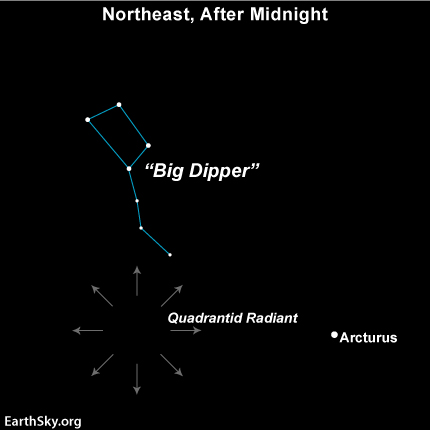The first meteor shower of the new year is coming up fast. The Quadrantids is an annual meteor shower which occurs on or about Jan 3 of each year. This can be a very productive shower, producing upwards of 50 to 100 meteors (often bright) per hour. But it can also be a very narrow shower, lasting only a few hours at peak (unlike the better known showers Perseids and Geminids which can last several days).
Like all meteor showers, the Quadrantids are named after a constellation from which the meteor “appear” to radiate from. Meteors don’t actually come from the constellation – the stars composing the constellation are far beyond our solar system. All meteors are remnants of comets or asteroids that reside within the solar system. But if you traced the path the meteors followed, they would appear to come from the same point in the sky in the area where the constellation is located. This particular shower is believed to be particles from the asteroid 2003 EH1 (2003 was when it was re-discovered and officially given a name). It may be the core of an extinct comet, possibly C/1490 Y1, discovered by Asian astronomers more than 500 years ago.
But where is the constellation Quadrantids you may ask? Actually, this is Quadrans Muralis (Mural Quadrant) which was defined in the late 1700’s, but was removed by the International Astronomical Union (IAU) in the early 1900’s when they defined the 88 constellations we use today. But this shower continues to use the constellation name that was given when they were discovered in the mid-1800’s. Quadrans Muralis was located between Bootes (the Shepard or Herdsman) and Draco (the Dragon).
The best “guess”timate of when the shower will peak is before dawn on Thur Jan 3. Look below the Big Dipper and to the left of the bright star Arcturus (in Bootes). This is where the meteors will appear to come from. The meteors may not appear directly in this area, but in a wider circumference around this point and radiating away. As with all meteor showers, special equipment is not required to enjoy this show. The best is to lay out on the ground facing up to view as much of the sky as possible. Of course being winter in Ontario, you’ll want to dress warmly, place a groundsheet/plastic sheet on the ground and perhaps bring a sleeping bag to keep warm. You can also use a lounge-chair to raise yourself off the ground. If you want to image this shower, then a wide-angle lens is best to cover as much of the sky as possible. And of course, the darker the sky, the more meteors you will see, so try to get away from city lights if you can.
The current forecast for Thur morning in our area is calling for a mix of clouds and clearing. The waning gibbous moon will also be still present which can wash out some of the fainter meteors. But it looks like there is a pretty good chance to see some of these. This will be the last good meteor shower until April’s Lyrids so get out there and have fun.
